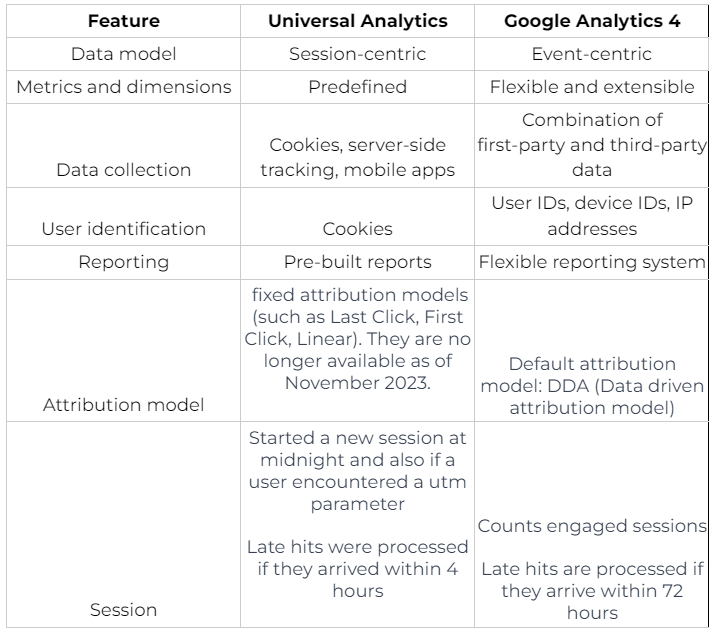In mid-2023, Google Analytics moved from Universal Analytics to Google Analytics 4 (GA4). Following this, a significant evolution has taken place in the digital sector, raising questions about the impact on affiliate tracking and attribution.
In this article, we explain why you’ll encounter more differences between your affiliate campaigns with this new version of Google Analytics. We reassure you that our tracking still works robustly, as nothing has changed in this area. To track data accurately, it’s essential to understand these differences
Differences between UA and GA4
First of all, you shall note that there are many differences between UA and GA4 which we list below, but the most important change is the attribution model.
By default, GA4 uses Data Driven model (DDA), which is slightly different from the last click non-direct model that was used by UA. This change impacts significantly the discrepancies between affiliate network tracking and what is registered on the GA4 side.
Indeed, GA4 is event-based. It means that distinct events (such as pageviews, events, interactions) are considered as one single session as long as it is contained within the 30 minutes time frame. It is the default setup that can be changed. For UA one interaction with an affiliate link was considered as a single session in GA settings. In UA, if new utm parameters were collected in the middle of the session (and they were different from the initial ones), the session was broken whereas in GA4 the session continues.
This change means not only fewer sessions registered but also the drop of conversions attributed to affiliate publishers. GA4 attributes a session to the first source of the click. Conversions depend on the attribution model chosen.
You can check the main changes listed below :

In GA4, you have a choice between 3 different attribution models:
- Data-driven attribution – as mentioned above, this is a default attribution model
- Paid and organic last click
- Google paid channels last click.
Data-driven attribution distributes credit for the conversion based on data for each conversion event. It uses the client’s account’s data to calculate the contribution of each click interaction. *
It is an interpretation of data based on machine learning and not the actual conversion recorded.
Paid and organic last click model ignores direct traffic and attributes 100% of the conversion value to the last clicked channel.*
Examples*
- Display > Social > Paid Search > Organic Search ? 100% to Organic Search
- Display > Social > Paid Search > Email ? 100% to Email
- Display > Social > Paid Search > Direct ? 100% to Paid Search
Note that Paid and organic last click (GA4) and Last non-direct click (UA) are two names for the same attribution model.
Google paid channels last click model assigns 100% of the conversion value to the last click from Google Ads channel.*
As mentioned above, the DDA attribution model set by default is the major cause of the significant tracking discrepancies, since affiliate marketing networks typically use a last-click attribution model.
On top of that, there may be other additional factors that can affect the numbers, such as:
- Different conversion windows: the attribution window for GA4 is 30 days. For the affiliate marketing networks it may vary depending on the agreements with the client which means that affiliate marketing networks may credit conversions to channels that occurred outside of the GA4 tracking window.
- Different channel definitions: Affiliate marketing networks and GA4 may have different definitions of channels. For example, affiliate marketing networks may consider email marketing to be a different channel than paid search, while GA4 may combine these two channels into a single “paid acquisition” channel.
- Data delays: There can be a delay between when a conversion occurs and when it is reported in GA4. This is because GA4 needs to process the data before it is available in reports.
- Data quality: The quality of the data that is collected by GA4 can affect the accuracy of the reporting. For example, if there are a lot of missing or inaccurate data points, then the reporting may be inaccurate.
- Data sampling: GA4 may use data sampling to reduce the amount of data that it needs to store and process. This can lead to fluctuations in the reported data.
- Session Source / Medium – gives information about traffic only and is only available in the traffic acquisition
- Source / Medium – gives more insights about the attribution of the conversion. However you will not find it in the report but you need to go to the Explorer and / or Advertising menu. This view offers useful information to better understand where the conversions go to.
- Consent: if there is no user consent, GA4 cannot assign traffic sources and it is automatically assigned as direct traffic.
Kwanko recommendations
To better follow up on the performances, we recommend that you perform the following actions:
- Use Google Analytics naming convention in UTM tracking (medium, source).
For a better follow-up on GA4, you should use the UTM as follow:
utm_source=Kwanko
utm_medium=affiliation
utm_campaign=Publisher_ID
- Fire marketing tag in the same trigger as the conversion event (Argann which is your transaction ID sent in Kwanko tracking).
- Use the conversion event name to add the needed parameter (this is important for conversions analysis).
- Create the custom dimension based on the new created parameter. This point is very important because only thanks to the custom dimension that contains the Transaction ID you will be able to understand where the conversions exactly are and to which channel they have been attributed. Please make sure that the Transaction ID is correctly sent to GA.
- Make sure that you exclude the referrers that should not be taken into consideration for conversion analysis, such as payment domains (PayPal or others).
- Use a last-click attribution model rather than DDA. It will not make all discrepancies disappear but it will be closer to the actual tracking. Go to: Admin > Data display > Attribution Settings > select ‘Paid and Organic channel: Last Click’ option.
- Do not hesitate to contact our team in case of any doubts or queries.
In a nutshell…
The switch to Google Analytics 4 brings with it significant differences in affiliate campaign tracking, mainly due to the DDA attribution model. To optimize tracking, Kwanko recommends using precise naming conventions, triggering marketing tags with conversion events, and using last-click attribution models. These measures enable better interpretation of data and optimization of affiliate strategies.
 SKALE
SKALE  Join Kwanko
Join Kwanko  Program Directory
Program Directory  Who is Kwanko
Who is Kwanko  History
History  Careers
Careers  Kwanko Academy
Kwanko Academy  News
News  Case Studies
Case Studies  Strategy and commitment
Strategy and commitment  Social Responsability
Social Responsability  Gender Equality
Gender Equality  Our Environmental Charter
Our Environmental Charter  Our Ethical Charter
Our Ethical Charter  Our responsible purchasing policy
Our responsible purchasing policy  Certifications and Publications
Certifications and Publications 






 Publishers
Publishers Advertisers
Advertisers Our Solutions
Our Solutions  About Us
About Us  Academy
Academy 










